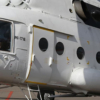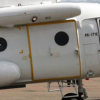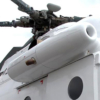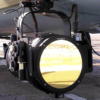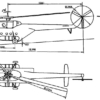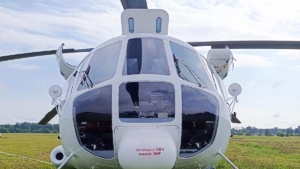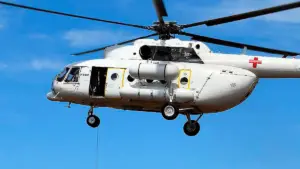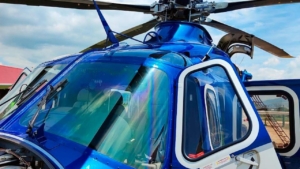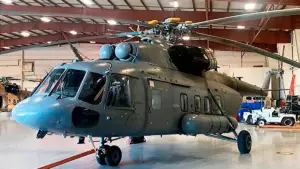Description
Common Data
The Mi-171E helicopter is an improved version of the world famous Mi-8 helicopter. More than 12 thousand Mi-8/Mi-17/Mi-171 helicopters were produced, of which about 4,000 were exported. Currently, Mi-8/Mi-17 helicopters are operated in more than 80 countries around the world. The total flight time of these helicopters exceeds 35 million hours.
The design, materials used, documentation, manufacturing technology and characteristics of the helicopter ensure its safe operation. The helicopter is operated in all climatic conditions: on land, at sea, in any microclimatic zone, including marine, tropical and cold climates, under the influence of sea fog and sea water.
The helicopter can be operated at outdoor temperatures from minus 50C to plus 50C and relative humidity up to 100%.
Main purposes of the Mi-171E
The Mi-171E is designed to solve a wide range of tasks. When the appropriate equipment is installed, the helicopter can be used to perform the following basic operations:
- transportation of passengers;
- transportation of cargo up to 4000 kg inside the cargo;
- compartment/on an external sling;
- search and rescue operations;
- evacuation of up to 12 people on sanitary stretchers and ambulance
- construction and installation works;
- patrolling;
- firefighting.
Mantenance And Service Life
Maintenance of the Mi-171E helicopter is carried out in accordance with the flight hours of the airframe and, subject to timely and high-quality implementation of the assigned procedures, ensures the required level of serviceability and readiness of the helicopter for flights.
The maintenance schedule (MS) is the main operational document that defines the maintenance objects (systems, subsystems and objects), the list and frequency of procedures performed.
The maintenance schedule provides for the following types of helicopter maintenance:
- line;
- periodical;
- special;
- when storing a helicopter;
- seasonal.
Line Service
Linear maintenance is carried out at the helicopter stand, ensures the use of the helicopter for its intended purpose and includes:
- Preliminary (auxiliary) operations;
- Work on visual inspection, maintenance and monitoring of technical condition;
- Departure and parking.
Periodic maintenance (scheduled maintenance operations)
Periodic maintenance is assigned to the TSN of the airframe in hours or after the last overhaul and consists of operations of the basic F-1 form, performed after every (50±10) hours of helicopter flight time and auxiliary work F = 2, 3, 4 and 5.
The need to perform these works is determined by the helicopter’s operating time every 100, 300, 500, 1000 flight hours, respectively, regardless of the tolerance allowed for previous periodic maintenance.
A uniform standard of ±10 hours of flight time is established for all periodic maintenance work. When carrying out phased maintenance, it is allowed to increase the flight hours to ±20 hours for work with a maintenance interval of 100 hours or more.
For engines, units and instruments, maintenance is assigned based on the airframe’s flight hours. In the event of replacement of the engine (engines) or other components due to expiration of service life or ahead of schedule, maintenance must be carried out in the form necessary for the airframe flight hours and auxiliary work:
- directly related to the replacement of the engine (engines) or its components;
- related to the inspection of airframe structural parts and parts of power supply systems, access to which is possible only with the engine or its components removed.
Subsequent maintenance of the engine (engines) and other components is carried out according to maintenance forms corresponding to the operating time of the airframe.
To ensure trouble-free operation of the helicopter in various climatic conditions, under conditions of intensive operation, when performing special tasks, as well as during long breaks between flights, the senior officer of the operator’s aviation technical service has the right to order additional work. or an additional periodic form of maintenance.
Special maintenance (unscheduled maintenance)
Special maintenance includes work after the helicopter is exposed to loads caused by abnormal operating conditions, such as:
- hard landing;
- flying in turbulent air;
- flying in stormy conditions (lightning strike);
- flight in icing conditions;
- exposure to hail or other storm conditions;
- exceeding flight limits during flight.
Warehouse service
Performed during temporary breaks in flights and consists of procedures:
- prepare the helicopter for storage;
- maintain the helicopter every (30±5) days, 3 months ±10 days, (6±1) months;
- prepare the helicopter for flights after storage.
Seasonal service
Seasonal maintenance is carried out by preparing the helicopter for the autumn-winter and spring-summer periods of operation.
All operations required in the Maintenance Manual are performed in accordance with the task cards included in the Helicopter Maintenance Manual and the Maintenance Procedures and Storage Manual included in the Component Operations Manual.




